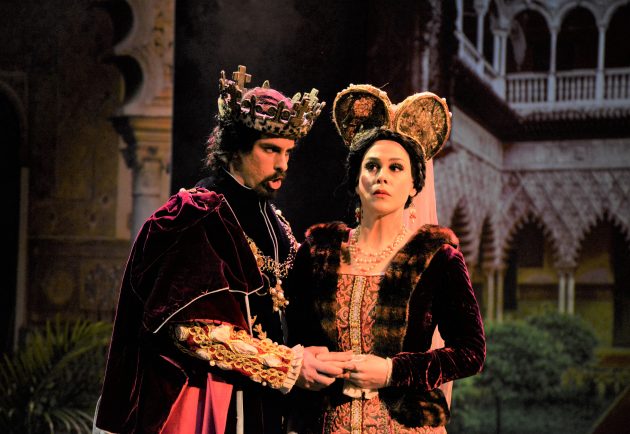
La Favorite by Gaetano Donizetti, performed in French by the Academy of Vocal Arts in Philadelphia, February 2020.
This review is re-running because the performance is being repeated on radio November 29.
Three of Italy’s greatest composers in the nineteenth century moved to Paris and wrote operas for the French public. We all know about Rossini’s Guillaume Tell and Verdi’s Don Carlos.
Much less familiar is La Favorite by Gaetano Donizetti. This 1840 work is in the grandiose French Grand Opéra tradition, including ballets and choral music as it dramatizes a love triangle concerning a king, a noblewoman who is the king’s mistress, and a monk.
Philadelphia’s Academy of Vocal Arts chose to stage this opera for the first time this month. Conductor Richard A. Raub edited the score to simplify the heavy orchestration and eliminate most of the ballets and choruses. Thus it became an educational experience for the AVA’s young singers to dip their toes into an unfamiliar repertoire. For the public, it’s an interesting story that involves rivalry between church and king (like Don Carlos) and a woman named Léonor who disguises herself as a young man to find refuge in a monastery (like Verdi’s La forza del destino.)
A young monk and Léonor fall in love and she is afraid to tell him that she’s the king’s mistress. Complications ensue when the monk becomes the commander of an army unit which defeats the Moors and the king congratulates the young man, not knowing that they’re both involved with the same woman. An unusually nice plot touch is that the king is not a conventional villain. Instead, he seems fond of Léonor and sincerely wishes the couple happiness.
The opera has only been performed at the Metropolitan in an Italian version that was disowned by Donizetti, and not done at all between 1905 and 1978, when I saw a revival starring Shirley Verrett and Luciano Pavarotti. Those artists were not at their best, and the opera has not appeared there since. The AVA singers are more stylish and seem comfortable with the French style and diction.
I prefer this French version which has a more logical story than the Italian. And it’s good to hear what the composer intended. Donizetti’s orchestration is ingenious, as when a harp and plucked violins and celli accompany Léonor’s big aria “O mon Fernand,” and when the king sings with English horn and low strings in a last-act prayer.
The Academy double cast the opera, as is its custom. I attended the final performance and was pleased to see less-experienced principals. Mezzo-soprano Pascale Spinney sang Léonor with musicality and, in the latter half, rose to dramatic intensity. Her up-tempo cabaletta to “O mon Fernand” included some intricate embellishments.
Tenor Sahel Salam, a first-year student from Texas, revealed a warm, plangent voice that maintained rich color throughout. It resonated authentically in the mask and in nasal passages, promising a good future in French and Italian lyric roles. His C-sharp above high C in his opening aria was exciting in the performance I saw, and his famous aria, “Ange si pur” (better-known as “Spirto gentil” in Italian) was stylish as it rose to, and smoothly descended from, a high C.
Reportedly, mezzo Anne Marie Stanley and tenor Oliver Sewell contributed more elaborate embellishments when they sang those roles.
Bass Eric Delarange was authoritative and sonorous as the Father Superior, and baritone Daniel Gallegos was sympathetic and vocally sumptuous as the king. Soprano Yihan Duan impressed in her small role as Leonor’s confidante.
Director Gregory Boyle devised clever ways of changing scenery and furniture while the curtain remained up between scenes, thus providing swifter flow. Elsewhere, his direction was conservatively traditional. Val Starr outdid herself in providing fancy period costumes. [See photo above.] The AVA orchestra sounded excellent, with lovely instrumental solos.
This article originally appeared in The Opera Critic, the website for opera professionals worldwide.